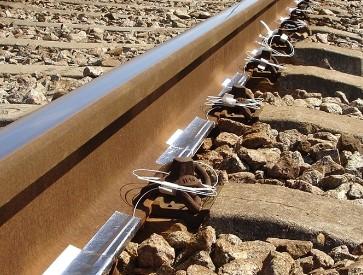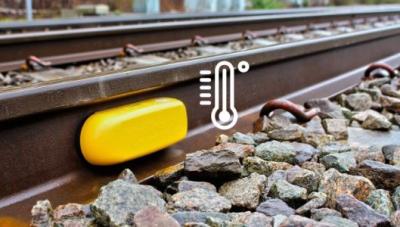The Feb. 3 freight train derailment in East Palestine, Ohio, caused by temperature fluctuations, highlights the critical role of temperature monitoring for safety and reliability of railway operations.
The derailment, which led to a broken rail and subsequent derailment, underscores the need for advanced temperature sensing technologies that can provide accurate and reliable data to prevent similar accidents in the future.
Temperature monitoring is a vital aspect of railway operations, as temperature fluctuations can cause significant damage to railway tracks and infrastructure, compromising the safety of freight and passenger trains.
According to John Calvin Willis, founder and senior software engineer at Moo Soft:“Temperature sensing systems are essential for monitoring and controlling the environment in which the train is traveling. They provide accurate readings of the temperature, which can be used to adjust the speed of the train, as well as the track itself.
“Temperature sensors can also be used to detect potential problems with the track, such as expansion and contraction due to temperature fluctuations. By monitoring the temperature, the train can be kept on the right track and avoid potential derailment.”
The National Transportation Safety Board posted an investigative update on March 21 of the Norfolk Southern Railway train derailment with the subsequent hazardous material release and fires.
Current temperature sensing technologies used in railway track monitoring systems
Railway track monitoring systems typically rely on temperature sensors to detect temperature changes that could compromise railway operations' safety and reliability. However, the current temperature sensing technologies used in these systems have limitations that can lead to inaccuracies and failures.
For instance, thermocouples and resistance temperature detectors (RTDs) are limited in their accuracy, with measurements potentially deviating from actual temperatures by as much as 5 to 10 degrees Celsius. This can lead to inaccurate data and potentially missed warning signs of temperature-related damage to railway infrastructure.
Additionally, traditional sensors can be vulnerable to environmental factors such as moisture, vibration, and electromagnetic interference. These factors can compromise the accuracy of temperature readings and lead to sensor failures, compromising railway operations' safety and reliability.
Traditional sensors also require regular maintenance to ensure their accuracy and reliability. However, the maintenance requirements can be time-consuming and costly, requiring significant resources from railway companies and maintenance crews.
Despite these limitations, traditional temperature sensing technologies have been the go-to choice for railway track monitoring systems for decades.
However, the recent freight train derailment incident highlights the need for more advanced temperature sensing technologies to provide more accurate and reliable temperature data to prevent similar accidents in the future.
Fortunately, newer, more advanced temperature monitoring technologies, such as fiber optic sensors, can provide more accurate and reliable temperature data.
Advanced temperature monitoring technologies for railway track monitoring systems
Fiber optic sensors use optical fibers to measure temperature changes along the length of railway tracks. These sensors can provide temperature data at a higher resolution than traditional sensors, with accuracy levels of up to 0.1 degrees Celsius.

Compared to traditional temperature sensing technologies such as thermocouples and RTDs, fiber optic sensors offer several advantages, including:
-
Higher accuracy: Fiber optic sensors can provide temperature data at higher resolution with accuracy levels of up to 0.1 degrees Celsius, compared to traditional sensors that can deviate by as much as 5 to 10 degrees C.
-
Immunity to electromagnetic interference: Fiber optic sensors are immune to electromagnetic interference, making them more reliable in noisy environments with significant electrical activity.
-
Harsh environment tolerance: Fiber optic sensors can withstand harsh environmental conditions such as moisture, vibration, and extreme temperatures, which can compromise the accuracy and reliability of traditional sensors.
Unlike fiber optic sensors, Infrared thermography sensors use thermal imaging cameras to detect changes in temperature along railway tracks. This technology can provide high-resolution temperature data in real-time, making it ideal for detecting temperature-related damage before it becomes a safety concern.
Wireless temperature sensors can be used along railway tracks to provide continuous temperature monitoring data without the need for wired connections.

These sensors can be accessed remotely and can send alerts in real-time if temperature readings exceed a certain threshold.
Despite the potential benefits of newer temperature sensing technologies, implementation and maintenance challenges need to be addressed. These challenges include cost, compatibility with existing infrastructure, and the need for skilled personnel to install and maintain these technologies.
Nonetheless, implementing more advanced temperature monitoring technologies can help improve the safety and reliability of railway operations, and stakeholders need to continue investing in research and development in this field.
Challenges in implementing advanced temperature monitoring technologies
While there are promising advancements in temperature monitoring technologies for railway track monitoring systems, there are several challenges that need to be addressed before they can be widely implemented. These challenges include:
-
Cost: Advanced temperature monitoring technologies, such as fiber optic sensors, infrared thermography, and wireless temperature sensors, can be expensive to implement and maintain. This cost can be a significant barrier for smaller railway companies that may not have the financial resources to invest in these technologies.
-
Compatibility with existing infrastructure: Implementing new temperature monitoring technologies requires compatibility with existing infrastructure, including communication networks and data management systems. Integrating these new technologies with legacy systems can be challenging and may require additional investments in infrastructure.
-
Maintenance and calibration: Advanced temperature monitoring technologies require regular maintenance and calibration to ensure they are providing accurate data. This maintenance can be time-consuming and requires skilled personnel to perform.
-
Data management: Advanced temperature monitoring technologies generate a large amount of data that needs to be managed and analyzed. Railway companies may not have the necessary data management systems in place to effectively collect, store, and analyze this data.
-
Privacy and security: The implementation of advanced temperature monitoring technologies raises privacy and security concerns. Railway companies need to ensure that the data collected by these technologies is secure and not used for unintended purposes.
Importance of temperature monitoring in ensuring railway safety
Proper railway temperature monitoring is similar to taking the necessary precautions to prevent car issues during winter. Some of the key reasons why temperature monitoring is vital for ensuring railway safety include:
-
Preventing track failures: Temperature monitoring can help identify potential track failures before they occur. By monitoring temperature changes, railway companies can detect abnormal temperature patterns that may indicate an issue with the track. This can allow for maintenance or repair work to be done before a track failure occurs, reducing the risk of derailments and other safety incidents.
-
Maintaining track integrity: Temperature monitoring can help ensure that railway tracks remain structurally sound. Extreme temperature fluctuations can cause tracks to expand or contract, leading to issues with the track's integrity. By monitoring temperatures, railway companies can ensure that tracks are maintained at a consistent temperature, reducing the risk of track damage.
-
Improving operational efficiency: Temperature monitoring can help improve operational efficiency by allowing railway companies to better understand how their tracks are performing. By monitoring temperature data, railway companies can identify patterns and trends that can help optimize maintenance schedules and reduce downtime.
-
Enhancing safety: Temperature monitoring can ultimately enhance safety by reducing the risk of accidents and incidents on the railway. By monitoring temperatures and addressing potential issues before they become a safety hazard, railway companies can help ensure the safe and reliable operation of their systems.
The future of temperature monitoring for railway operations
As technology continues to advance, there is significant potential for temperature monitoring to play an increasingly important role in ensuring the safety and reliability of railway systems.
Some of the future directions for temperature monitoring in railway operations include:
-
Integration with other monitoring technologies: In addition to temperature monitoring, there are a variety of other technologies that can be used to monitor railway systems, such as vibration sensors and acoustic sensors. Integrating temperature monitoring with these other technologies can provide a more comprehensive view of the health of the railway system and allow for more accurate predictions of maintenance needs.
-
Use of machine learning and predictive analytics: Machine learning and predictive analytics can be used to analyze large amounts of temperature data and identify patterns and trends that may not be visible through traditional analysis. This has huge potential because the machine-learning industry is growing and is expected to expand by at least 38.8% by 2029.
-
Development of more advanced temperature sensing technologies: There is ongoing research into developing even more advanced temperature sensing technologies, such as nanosensors and flexible sensors. These technologies have the potential to provide even more accurate and detailed temperature data, allowing for even more precise maintenance and repair work.
-
Improved data management and sharing: As the amount of data generated by temperature monitoring technologies continues to increase, it will be important to have robust data management and sharing systems in place. This will allow railway companies to collect, store, and analyze data more effectively and to share information with other stakeholders, such as regulatory bodies and other railway companies.
Conclusion
Temperature monitoring is critical to ensuring railway safety. Extreme temperature fluctuations can cause significant damage to railway tracks, leading to derailments and other safety incidents. By monitoring temperature changes, railway companies can take preventative measures to address potential issues before they become a safety hazard.
Nahla Davies is a software developer and tech writer. Before devoting her work full time to technical writing, she served as lead programmer at an experiential branding organization serving such clients as Samsung,Time Warner, Netflix, and Sony.